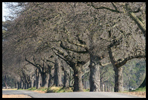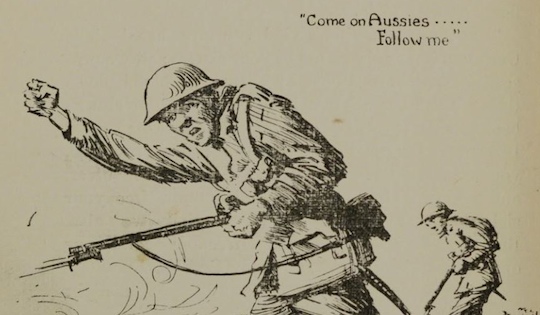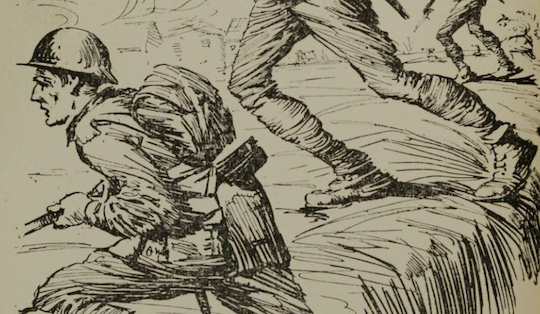AustLit
-
Since 2012 the AustLit team, with content development led by researcher Robert Thomson, has gathered information about a range of literary forms where the war is a subject or the author was involved in the conflict. The forms covered include:
- poetry
- short stories
- novels
- plays
- films
- popular songs
- children’s literature
- biographies and personal accounts
- literary criticism … and more.
A rich collection of more than 5,000 AustLit records for works has been created or updated during the course of the project. In addition, hundreds of authors have also been identified. Each of these records have been tagged with a World War I identifier to enable targeted searching for the people, organisations, and works influenced by or dealing with the war.
Some of the exhibitions and web pages associated with this project have been built by AustLit researchers Dr Clay Djubal and Dr Catriona Mills based on their research into theatre, film, and popular and children's fiction of the period.
Kerry Kilner has been overall project manager and General Editor.
-
AustLit
Much of the project has in effect involved building on and expanding existing AustLit bibliographic and biographical records that have been compiled over the past decade or so. AustLit has perhaps been the most important source.
Fryer Library Collection
The University of Queensland's Fryer Library has one of the most comprehensive collections of World War I literature in Australia, perhaps only bettered by the Australian War Memorial.
To date, we have surveyed a good deal of the World War I literature held at the Fryer Library, and have used the Fryer material to index individual works in the various selections, collections, anthologies, and journals.
In most cases, the authors were already listed in AustLit, but we have often found additional biographical material in the various works assessed for inclusion. The survey of Fryer Library material remains a work in progress.
Newspapers and magazines
The contemporary newspapers and magazines, from 1914 through to around 1939, have been one of the most important sources for identifying material previously unrecorded.
So much of the material in the contemporary newspapers has been revelatory and a lot of it has probably escaped the attention of earlier generations of microfilm researchers who haven’t had the benefit of the National Library of Australia's newspapers database, available through Trove, with its text recognition and search functions. In most instances, we have focused on the digitised newspapers available via Trove and Google News Archive.
In some instances, it has been necessary to resort to microfilm research (the Bulletin, The Labor Call, The Australian Worker, and Smith’s Weekly, and others.
In addition to literary works, newspapers have been a major source of biographical information on the World War I authors included here. Newspapers have also provided information on the theatre troupes and entertainers operating both at the various theatres of war and on the home front.
Many new additions have been made to the Trove digitised newspaper stable in the last year or so, including the lesser-brow and low-brow newspapers. Many of these contain a wealth of World War I material, and they often provide a different perspective on the war to the hi-brow publications (e.g., the Melbourne Weekly Times, which published a number of Sumner Locke’s wartime short stories: see the Sumner Locke exhibition). Many of the recently digitised regional newspapers are also significant. They provide insights into the way the war was reported in country districts and often contain literary works not (yet) found in the metropolitan press. The survey of literary material in the newspapers also remains a work in progress.
The survey of the newspapers has involved:
- Comprehensively indexing the Sydney Mail in the years 1914-1919—this has turned up poetry, biographical snippets, info on Digger theatre troupes, etc.
- Comprehensively indexing the radical left-wing Melbourne newspaper The Labor Call (Fryer Library microfilm) for the years 1914-1919.
- Selectively indexing many other newspapers and magazines. For example, The Australian Worker (Sydney), The Worker (Brisbane).
- Revisiting the records for the Bulletin for the period 1914-1918 to gain a better sense of how that influential magazine covered the war and the range of literary material it carried.
- Selectively indexing Smith’s Weekly, which championed the cause of returned Diggers in the inter-war years.
- Comprehensively indexing the two major World War I army magazines: The Kia-Ora Coo-ee and Aussie, both of which commenced publication in 1918.
- Comprehensively indexing The Anzac Book (1916).
The project has mined the various Australian libraries for all manner of World War I related material. The National Library of Australia, the various state libraries, and the National Film and Sound Archive have proved rich sites of information:
- The NLA has a fairly comprehensive collection of wartime popular songs, and their photographic collection includes a number of portraits of wartime authors that have been added to AustLit biographies.
- The NFSA has enabled us to firm up production details for the various World War I related films, and a large amount of material on theatre and film has also come via the NLA and the various state libraries.
- The Australian War Memorial records available on-line (World War I Nominal Rolls, Embarkation Rolls, Red Cross files) have all been invaluable sources of biographical material on many of the soldier authors.
Other sources
Overseas libraries (e.g., the British Library), Wikipedia articles, family history websites, various journal articles, and numerous histories of the War and its aftermath have also been used to identify and explore avenues of research.
-
The University of Queensland initially funded the project through the Major Infrastructure and Equipment fund in 2012 and 2014. The Australian Research Council also provided funding in 2013 through the Linkage Infrastructure Equipment and Facilities scheme.
You might be interested in...






